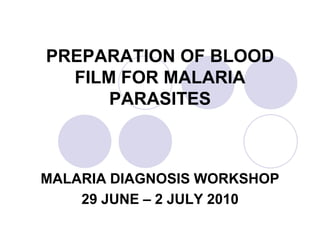
Preparation of blood films for malaria parasites
- 1. PREPARATION OF BLOOD FILM FOR MALARIA PARASITES MALARIA DIAGNOSIS WORKSHOP 29 JUNE – 2 JULY 2010
- 2. Two types of blood film for malaria parasites Thick Blood Smear – use to determine if parasite is present. Thin Blood Smear – use to confirm the Plasmodium species present
- 3. Before making blood film… Wear gloves prior to taking blood samples or handling blood. Avoid getting blood, including dry blood from films, on your fingers or hands. Cover cuts on your hands with waterproof dressing. Avoid accidentally pricking yourself when handling sharp instruments Wash your hands with soap and water after you finish a job. If you get blood on your skin, quickly wipe it off with a cotton swab dampened with alcohol; then, wash the affected area with soap and water as soon as possible.
- 4. Materials for Preparation of Malaria Smears Clean and wrapped slides Sterile lancets 70% ethanol and water Absorbent cotton wool Surgical gloves Lint-free cotton cloth Slide box or cover to exclude flies and dust Record form or register Soft lead pencil; ball-point pen
- 5. PROCEDURES: 1. RECORD PATIENT DETAILS ON A REGISTER
- 6. Get ready clean microscopic slide glass slides of superior’ quality, with frosted end. The frosted end should be used to label the slide.
- 7. PREPARATION OF BLOOD FILM FROM FINGERPRICK 2. Wear glove and hold the patient’s left hand with palm facing upwards. Select third finger from the thumb The thumb should never be used for adults or children. Note : Good films may be prepared directly from fingerprick blood,
- 8. Clean the finger with a piece of cotton wool lightly soaked in 70% ethanol. Dry the finger with a clean cotton cloth, using firm strokes to stimulate blood circulation.
- 9. For infant – use the toe
- 10. 4. Use sterile lancet to prick the finger
- 11. 5. Apply gentle pressure to the finger to allow the blood to ooze out 6. Wipe off the first drop 7. Apply further gentle pressure for more blood
- 12. 8. Place blood on clean glass slide to make thick and thin blood film on a slide
- 13. Place the spreader slide in contact with the drop of blood at an angle.. Let blood spread along the edge of the spreader slide. gently push towards the other end of the slide
- 14. Angle too flat > film too long Angle too steep Thin Blood Film > film too short
- 15. Thin Film Good preparation - feathered end of the film should be centrally located on the slide with free margins on both sides, when properly prepared, it will be only one cell layer thick at this end. Badly prepared smears can cause presence of streaks - as a result of chipped spreader holes in the film indicate faulty preparation and dirty or greasy slides, respectively.
- 16. TOO MUCH BLOOD OK Combination of thick and thin blood on the same slide
- 17. Thick blood film – spread the drop of blood using a corner of the spreader. Spread the drop in one circular direction to make even thick film, size of a 1 cm diameter. Do not stir the blood.
- 18. Preparation of thick blood film using ……. Plastic pipette
- 19. Using wooden stick
- 20. Good thick blood film • The right thickness, • You should be able to read the newspaper,
- 21. Avoid doing these It should be round Thick film too thick
- 22. Labeling With frosted end use a pencil Without frosted end use diamond pencil Do not label on the blood film Do not use a ball pen Do not use a paper label
- 23. Drying slides Incubator 37oC Hair dryer? Leave standing on a A fan? rack on lab bench In a slide tray with the cover open Do not leave on the bench in a laboratory unattended because it will be eaten by insects. Slides must be dried completely before they are packed for storage or transport.
- 24. Venous blood can be used instead of from finger prick Use vacutainers with anticoagulant (EDTA)
- 25. For preparing thin and thick films use a glass capillary to drop the ETDA-blood. plastic pipette ? Yes provided no air bubles
- 26. The use of anticoagulated (EDTA) blood may cause the following : smears require longer time to dry thick smears tend to flake from the slide stain quality is affected, stippling of infected RBC’s may not be visible parasite forms may be distorted and may lyse RBC’s may become crenated and look fimbrinated
- 27. Prepare smears as soon as possible after collecting venous blood (less than 2 hours after collection) to avoid: Changes in parasite morphology Changes in the RBC morphology (these effects can compromise correct identification of species) Staining characteristics
- 28. Thank You For your attention